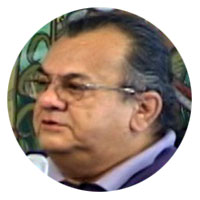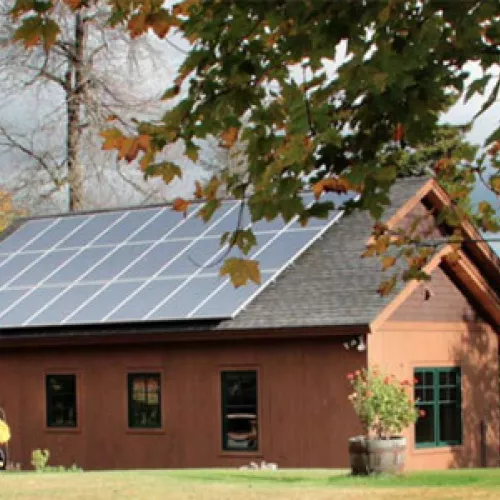Imagine a project combining efficient housing that can be assembled on-site with solar panels made in Minnesota and manufacturing and deployment all taking place on Native American lands. It’s real! We dug into the details with Wakaigon Innovations CEO Mike Myers about just such a project coming to life in Leech Lake.
 How did this effort get started, and who is involved?
How did this effort get started, and who is involved?
Mike Myers: Wakaiagon Innovations, LLC is a tribally-chartered corporation headquartered in Cass Lake, MN with the specific focus of addressing the acute housing needs in Indigenous communities throughout North America. We’re working through Leech Lake Financial Services, Inc. and its subsidiary Aki Development.
In 2015, Leech Lake Financial Services contracted Wakaiagon to assist in identifying, planning, and implementing economic and community development projects. These activities have led to the establishment of an LED lighting assembly and testing operation, as well as Aki’s acquisition of 60% of Saga Solar, a solar panel manufacturing company certified through the state Made in Minnesota incentive program.
Can you tell us about the housing need you’ve identified and how you’re addressing it?
Mike Myers: Not only is there the physical need for housing, there is the need for housing that is affordable, energy efficient, economical to live in, and built to a higher standard than the current housing stock. Throughout North America there is an immediate need for 385,000 houses. In Minnesota, according to HUD, there is an immediate need for 6,768. This is a very daunting number, and it has not been reduced in decades. You can learn more about the need and our plans in this report: Wakaiagon Innovations, LLC: Indigenous Housing for Seven Generations.
In 2009, I was the Director of Tribal Development for Leech Lake, and had the opportunity to meet with Pat Donahue of UMD’s Natural Resource Research Institute (NRRI) and see their work in developing Ready To Assemble (RTA) housing. What I saw was the emerging answer for addressing this chronic housing crisis. The House Cubed prototypes had been developed in answer to a FEMA RFP for what they were terming Rapid Deployable Housing to replace the disastrous trailers they had used after Hurricane Katrina.
From the outset the House Cubed homes have been designed to achieve the following goals:
- Housing built to a higher standard and surpasses current codes;
- Housing that is durable and robust to withstand a wide variety of climates and conditions;
- Housing that achieves the highest efficiencies possible, lowering occupancy costs;
- Housing that meets and/or exceeds LEED standards; and
- Housing that is economically doable, producing a greater return on investment for customers.
We’re sourcing as much as we can locally. Each house will include LED lighting manufactured by Aki Development, solar panels supplied and Saga Solar, and solar hot water systems from Sun Bandit by Next Generation Energy. Windows and doors will be supplied by Marvin Windows. We have chosen their energy efficient high impact windows as an integral part of our Resilient Homes initiative. Most Indigenous housing authorities spend more than 1/3 of their budgets on repairs and renovations to existing housing stock. The windows and doors we have chosen will help reduce these costs.
Tell us about your planned manufacturing process.
Mike Myers: The House Cubed Business Plan outlines the establishment of a Central Factory along with several mini factories. The Central Factory will offer on-going technological, research, and engineering support to the mini-factories.
Homes will be constructed dramatically faster than traditional built homes. A 1,200 square foot home can be built in as little as 150 hours. Each mini factory can complete three homes per week. With our streamlined engineering process we also estimate that we’ll see a labor cost savings of 10-15% over traditional modular homes.
The creation of a Central Factory and several mini factories spreads the costs of manufacturing over hundreds of homes versus one home being built at a time. All of these factors combine to bring an affordable home equipped with technologies, savings, and efficiencies that would not normally be seen in homes for low to middle income families.
When do you hope to break ground?
Mike Myers: Aki has begun its LED lighting operations and is hoping to have its Saga Solar operations fully up and going soon. The plan for House Cubed is to establish a Beta Factory in Proctor, MN by early 2017. This factory will be “broken in” with the manufacturing of 20 homes for the Leech Lake Housing Authority. Once any kinks are worked out it is then planned to establish the first mini factory in Cass Lake by late 2017.
Hand-in-hand with these developments we have been in discussions with other parties about creating a financing capacity that can assist Indigenous governments, housing authorities, and other entities with the up-front costs of projects. The lack of financing and heavy dependence on government grants have been a hindrance to more aggressively addressing Indigenous housing and energy issues.
Any last thoughts you would like to share?
Mike Myers: As far as we can tell there are no similar partnerships or collaborations occurring anywhere else in North America. We have been commended by several organizations for the innovative approaches we’ve developed.
We believe we’ve been successful due to several factors that come from our cultural teachings and are intrinsic to our approach to development. First, we are able to articulate and set out a common agenda that all of the parties can become a part of while still maintaining their autonomy to pursue their own growth. This then, secondly, leads to mutually reinforcing approaches and activities. Thirdly, there is constant communication amongst all of the participants. In the midst of this communication natural alliances emerge. What we mean by this is that individual participants are able to identify other ancillary interests they can pursue separate from the larger group that will eventually bring benefit to the greater goal. This ability to envision a greater good coupled with the fluidity and natural dynamics of pursuing a vision has been an Indigenous strength for generations.
Lastly, everyone knows we are not planning only for today or for a short-term future. The glue that holds this together is the shared belief that what we are doing needs to bring benefits to the seventh generation in the future.
Anyone who wants to learn more or sees opportunity for partnership can contact me at 218-766-6718 or [email protected].


